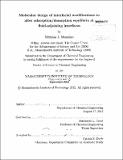| dc.contributor.advisor | Bernhardt L. Trout. | en_US |
| dc.contributor.author | Musolino, Nicholas J | en_US |
| dc.contributor.other | Massachusetts Institute of Technology. Department of Chemical Engineering. | en_US |
| dc.date.accessioned | 2013-06-17T19:47:27Z | |
| dc.date.available | 2013-06-17T19:47:27Z | |
| dc.date.copyright | 2012 | en_US |
| dc.date.issued | 2013 | en_US |
| dc.identifier.uri | http://hdl.handle.net/1721.1/79206 | |
| dc.description | Thesis (Sc. D.)--Massachusetts Institute of Technology, Dept. of Chemical Engineering, February 2013. | en_US |
| dc.description | "February 2013." Cataloged from PDF version of thesis. | en_US |
| dc.description | Includes bibliographical references (p. 151-168). | en_US |
| dc.description.abstract | The thermodynamics and mass transfer kinetics of adsorption and desporption at interfaces play vital roles in chemical analysis, separation processes, and many natural phenomena. In this work, computer simulations were used to design interfacial modifications to alter the physical processes of adsorption and desorption, using two different approaches to molecular design. In the first application, the finite-temperature string method was used to elucidate the mechanism of water's evaporation at its liquid/vapor interface, with the goal of designing a soluble additive that could impede evaporation there. These simulations used the SPC/E water model, and identified a minimum free energy path for this process in terms of 10 descriptive order parameters. The measured free energy change was 7.4 kcal/mol at 298 K, in reasonable agreement with the experimental value of 6.3 kcal/mol, and the mean first-passage time was 1375 ns for a single molecule, corresponding to an evaporation coefficient of 0.25. In the observed minimum free energy process, the water molecule diffuses to the surface, and tends to rotate so that its dipole and one 0-H bond are oriented outward as it crosses the Gibbs dividing surface. As the molecule moves further outwards through the interfacial region, a local solvation shell tends to protrudes from the interface. The water molecule loses donor and acceptor hydrogen bonds, and then, with its dipole nearly normal to the interface, stops donating its remaining donor hydrogen bond. After the final, accepted hydrogen bond is broken, the water molecule is free. An analysis of reactive trajectories showed that the relative orientation of nearby water molecules, and the number of accepted hydrogen bonds, were important variables in a kinetic description of the process. In the second application, we developed an in silico screening process to design organic ligands which, when chemically bound to a solid surface, would constitute an effective adsorption for a pharmaceutically relevant mixture of reaction products. This procedure employs automated molecular dynamics simulations to evaluate potential ligands, by measuring the difference in adsorption energy of two solutes which differed by one functional group. Then, a genetic algorithm was used to iteratively improve a population of ligands through selection and reproduction steps. This procedure identified chemical designs of the surface-bound ligands that were outside the set considered using chemical intuition. The ligand designs achieved selectivity by exploiting phenyl-phenyl stacking which was sterically hindered in the case of one solution component. The ligand designs had selectivity energies of 0.8 to 1.6 kcal/mol in single-ligand, solvent-free simulations, if entropic contributions to the relative selectivity are neglected. This molecular evolution technique presents a useful method for the directed exploration of chemical space or for molecular design. | en_US |
| dc.description.statementofresponsibility | by Nicholas J. Musolino. | en_US |
| dc.format.extent | 229 p. | en_US |
| dc.language.iso | eng | en_US |
| dc.publisher | Massachusetts Institute of Technology | en_US |
| dc.rights | M.I.T. theses are protected by
copyright. They may be viewed from this source for any purpose, but
reproduction or distribution in any format is prohibited without written
permission. See provided URL for inquiries about permission. | en_US |
| dc.rights.uri | http://dspace.mit.edu/handle/1721.1/7582 | en_US |
| dc.subject | Chemical Engineering. | en_US |
| dc.title | Molecular design of interfacial modifications to alter adsorption/desorption equilibria at fluid-adjoining interfaces | en_US |
| dc.type | Thesis | en_US |
| dc.description.degree | Sc.D. | en_US |
| dc.contributor.department | Massachusetts Institute of Technology. Department of Chemical Engineering | |
| dc.identifier.oclc | 844743427 | en_US |
